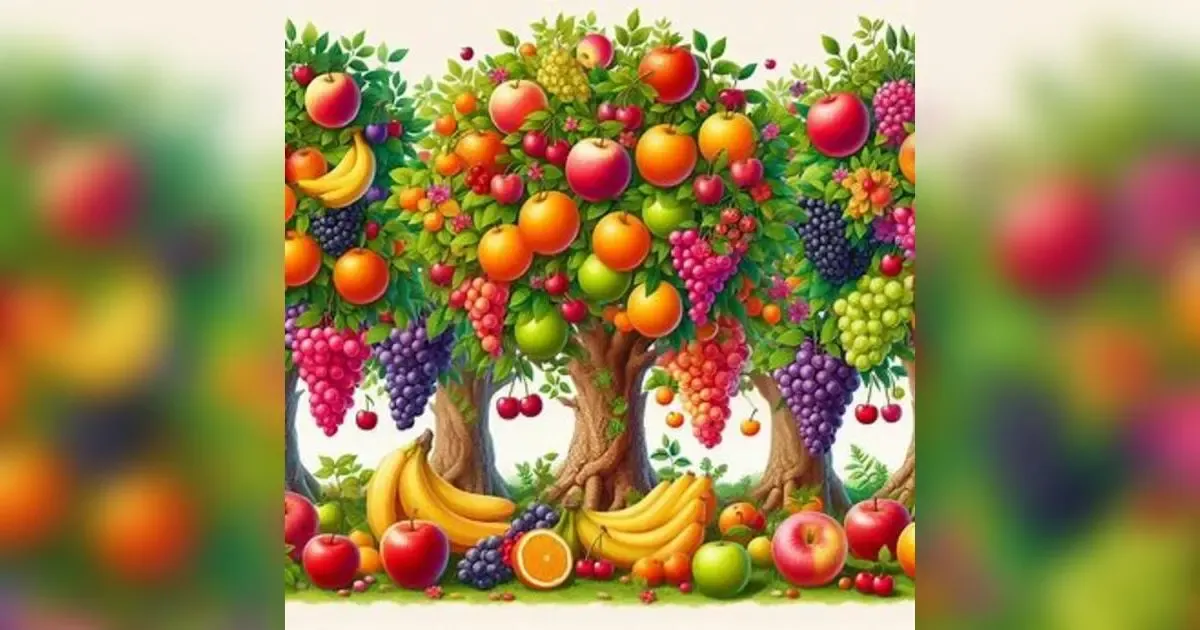This article will be your guide to the fascinating world of fast-growing fruit trees. We’ll explore a variety of styles, from sweet and tart citrus varieties like lemon powder to colorful fruits and stone fruits. We will examine the unique characteristics of each tree such as growth rate, fruiting season,mature size, and growth quality.Whether you are an experienced gardener or complete beginner,there is a fast growing orchard tosuut your needs and climate
Do you dream of going into your backyard orchard and plucking plump, juicy berries straight off the branches? While traditional fruit trees can take years to grow and produce fruit, there is a solution for the impatient gardener: fast-growing varieties! These superstars of the fruit tree world offer an appealing combination of fast growth and sweet fruit, often bearing fruit within a few short years of planting. Imagine the satisfaction of touching a homegrown peach in 3-4 years, or enjoying it for the first time in a basket full of fresh figs. Fast-growing succulents make this a reality, allowing you to enjoy your garden’s abundance sooner than traditional.
But speed isn’t the only benefit. Many of these fast-growing plants are also small, making them ideal for containers in small gardens or patios.They are perfect for urban dwellers and experts who still crave the taste of homegrown fruit.So, get ready to transform your garden into a sweet and productive escape. With a little planning and choosing a fast-growing orchard, you’ll enjoy the fruits of your labor (pun intended!) for quite some time.
Let’s embark on this journey together and discover the joys of growing our own fresh, delicious fruits! The satisfaction of growing your own juicy berries is incomparable. But waiting years for a young tree to grow can be dangerous. If you’re eager to reap the rewards of your gardening efforts, don’t worry! Many cool, fast-growing shrubs can decorate your yard and tempt your taste buds easily. This list explores 15 such exciting options, along with their unique characteristics and growing needs.
But speed isn’t the only benefit. Many of these fast-growing plants are also small, making them ideal for containers in small gardens or patios.They are perfect for urban dwellers and experts who still crave the taste of homegrown fruit.So, get ready to transform your garden into a sweet and productive escape. With a little planning and choosing a fast-growing orchard, you’ll enjoy the fruits of your labor (pun intended!) for quite some time.
Let’s embark on this journey together and discover the joys of growing our own fresh, delicious fruits! The satisfaction of growing your own juicy berries is incomparable. But waiting years for a young tree to grow can be dangerous. If you’re eager to reap the rewards of your gardening efforts, don’t worry! Many cool, fast-growing shrubs can decorate your yard and tempt your taste buds easily. This list explores 15 such exciting options, along with their unique characteristics and growing needs.
1. Loquat (Eriobotrya japonica):
This subtropical wonder when planted or aerated produces clusters of sweet and tart coconut fruit in just 1-2 years Loquat trees thrive in only 8 -11 locations of land a good drainage and 6 hours of sunlight a day . Their bright evergreen foliage provides a bit of beauty throughout the year.
2. Asian Pear (Pyrus pyrifolia):
Offering a refreshing crack of crunchy texture and a hint of melon, Asian pears can start bearing fruit in 3-4 years. Choose varieties best suited to your climate and remember, they need another pear tree nearby to harvest their pollination.
3. Grapes (Ficus carica):
Preferred for its versatility, the fig tree can be enjoyed fresh, dried or preserved. Even some incredibly fast growing varieties are able to fruit in the first year, while most take 3-5 years. Grapes are self-sustaining and thrive in warm climates with well-drained soil.
4. Mulberry tree (Morus spp.):
This fast-growing (up to 1 foot per year) and hardy tree provides refuge for wildlife and humans Mulberry trees, especially evergreens, can start producing sweet fruit and wet in just 2-3 years . They self-pollinate, making them ideal for beginners.
5. Jujube (Ziziphus jujuba):
Commonly known as the Chinese date, jujube is a small round fruit with flavors ranging from sweet to bitter. Depending on the variety, jujube trees can start producing in just 3-4 years. They are drought and soil resistant.
6. Pawpaw (Asimina triloba):
Native to North America, pawpaw trees boast large, tropical-looking fruits with a creamy texture and a taste reminiscent of mango and banana. These fast growers can start fruiting within 5 years and are perfect for attracting pollinators.
7. Dwarf Peach (Prunus persica):
If you have limited space, dwarf peach trees are your answer. Sweet peaches can be established in just 2-3 years reaching a mature height of only 6-8 feet. Make sure they get at least 6 hours of direct sunlight a day.
8. Dwarf plums (Prunus domestica):
Like dwarf peaches, dwarf plum trees are ideal for small gardens. They take a while to bear fruit, usually 3-4 years, but you are rewarded with juicy fruit that is perfect for you to eat fresh or use in jam-preserves.
9. Honeycrisp Apple (Malus domestica 'Honeycrisp'):
Standard apple trees take longer to mature, but some dwarf varieties like Honeycrisp can start fruiting in 3-4 years These trees need pruning and care though that it produces an incredibly rich and crisp apple.
10. Blueberry trees (Vaccinium spp.):
Technically not trees, blueberry trees are fast growers that can start producing sweet fruit in 1-3 years. Remember, they like acidic soil and plenty of sunlight for best results.
11. Kiwi (Actinidia deliciosa):
Who doesn’t love homegrown kiwi? While some vines take longer, some kiwi vines can start producing within 3-4 years. They need well-drained soil, a strong foundation and male and female plants to provide pollination.
12. Tayberry (Rubus spp.):
A unique hybrid of raspberries and blackberries, tayberries are hardy things that can bear fruit in 2 years. These sharp, tangy berries are perfect for jams, pies, or just to enjoy fresh.
13. Gooseberries (Ribes grossularia):
These thorny shrubs produce sharp, tart fruits ideal for jams, jellies and pies. Gooseberry trees can begin fruiting in 2-3 years and require little maintenance.
14. Currants (Ribes spp.):
Like gooseberries, currant buds are red-black-white. They are quick planters, some fruiting as soon as 2 years. Currants are also a great addition to jams, jellies and wine.
15. Youngberry (Rubus spp.):
Another attractive hybrid, Youngberry is a hybrid.Plant your youngberry in full sun for good flower and fruit production. They are creepers, requiring a trellis or fence to grow up.
Fast-growing fruit trees: frequently asked questions
Planting an orchard is an investment that promises years of delicious home-grown food. But what if you are impatient to reap the benefits? Don't be afraid! Many fast-growing fruit trees can quench the appetite for fresh produce in a surprisingly short time. This FAQ dives into everything you need to know about these fast growing fruits.
Q: What fruit trees grow fastest?
A: Many farmers are competing for the fastest growing orchard. Here are some of the pioneers:
✓Grapes: These sun-loving plants can start producing in their first year!
✓Asian Pear: Get ready to enjoy your crisp and tasty flesh in just 2-3 years with proper care.
✓Loquats: This wonderful healing can begin to show in 1-2 years if planted or aerated.
✓Mulberries: Be prepared to keep birds away from these beautiful fruits, as they can begin fruiting in less than 5 years.
✓Dwarf varieties of many fruits: Many common fruits such as apples, peaches and plums come in dwarf varieties that grow rapidly to small sizes and bear fruit in about 3-4 years
✓Grapes: These sun-loving plants can start producing in their first year!
✓Asian Pear: Get ready to enjoy your crisp and tasty flesh in just 2-3 years with proper care.
✓Loquats: This wonderful healing can begin to show in 1-2 years if planted or aerated.
✓Mulberries: Be prepared to keep birds away from these beautiful fruits, as they can begin fruiting in less than 5 years.
✓Dwarf varieties of many fruits: Many common fruits such as apples, peaches and plums come in dwarf varieties that grow rapidly to small sizes and bear fruit in about 3-4 years
Q: How long does it take for an orchard to bear fruit?
A: Patience is a virtue, but some trees have better habits than others. Here is the typical delivery date:
✓ Very early (1-2 years): fig, loquat (cultivated/aerated) .
✓ Early (3-4 years): Asian pears, dwarf fruit trees (peaches, plums, etc.).
✓ Medium (4-5 years): citrus, mulberry
✓ Slower (5+ years): Prolific full-sized fruit trees (apples, cherries, etc.).
✓ Very early (1-2 years): fig, loquat (cultivated/aerated) .
✓ Early (3-4 years): Asian pears, dwarf fruit trees (peaches, plums, etc.).
✓ Medium (4-5 years): citrus, mulberry
✓ Slower (5+ years): Prolific full-sized fruit trees (apples, cherries, etc.).
Q: Are there any downsides to fast-growing fruit trees?
A: While speed is enticing, consider these potential drawbacks.
✓ Life span: Fast growing trees generally have a short life span as compared to slow growing trees.
✓Size: A dwarf takes up less space, but they’re also less versatile. Full-sized trees produce bigger crops but require more patience.
✓ Maintenance: Some fast-growing trees may require multiple pruning to maintain size and yield.
✓ Life span: Fast growing trees generally have a short life span as compared to slow growing trees.
✓Size: A dwarf takes up less space, but they’re also less versatile. Full-sized trees produce bigger crops but require more patience.
✓ Maintenance: Some fast-growing trees may require multiple pruning to maintain size and yield.
Q: What are some tips to get out of it faster?
A: Here's how to turn your fast-growing tree into a fruiting machine.
✓ Start with healthy, mature trees: Choose trees from popular trees that are several years old and have old branches.
✓Choose the right location : Make sure your plants have enough sunlight (about 6-8 hours) and well-drained soil.
✓ Proper watering and fertility: Irrigate consistently during the growing season and according to your plant’s specific needs.
✓ Pruning: Prune at healthy rates to promote healthy growth and encourage fruit production. Identify the proper method of pruning for specific species.
✓ Start with healthy, mature trees: Choose trees from popular trees that are several years old and have old branches.
✓Choose the right location : Make sure your plants have enough sunlight (about 6-8 hours) and well-drained soil.
✓ Proper watering and fertility: Irrigate consistently during the growing season and according to your plant’s specific needs.
✓ Pruning: Prune at healthy rates to promote healthy growth and encourage fruit production. Identify the proper method of pruning for specific species.
Q: What is the conducive climate for growing shrubs fast growing fruits?
A: The best growing succulents for you depend on your climate. Here are the general guidelines:
✓Warm climates (zones 8-11): Figs, loquats, citrus trees, mulberry trees
✓Warm climates (zones 5-7): Asian pear, dwarf apple/peach/plum trees, cherries (a few varieties).
✓Remember: Look for specific species to ensure success in your climate and landscape.
With a little planning and care,you can enjoy homegrown seeds from your fast-growing tree in no time.So grab your gardening gloves,plant a tree,and get ready to taste the sweet fruit of patience (or important,as the case maybe)
✓Warm climates (zones 8-11): Figs, loquats, citrus trees, mulberry trees
✓Warm climates (zones 5-7): Asian pear, dwarf apple/peach/plum trees, cherries (a few varieties).
✓Remember: Look for specific species to ensure success in your climate and landscape.
With a little planning and care,you can enjoy homegrown seeds from your fast-growing tree in no time.So grab your gardening gloves,plant a tree,and get ready to taste the sweet fruit of patience (or important,as the case maybe)
Conclusion
In conclusion, with a little planning and choosing the right tree, you can enjoy homegrown fruit in a surprisingly short time. Fast-growing orchards produce delicious fruit even for those with little patience or experience. Remember that some research into your choice of varieties and proper care from planting to harvest will ensure a successful journey from replacement to sweet fruit . After a sweet reward, therefore these trees can also enhance your landscape, provide pollinator habitat and be good home grown which looks good for years to come ,for your own sake.


























